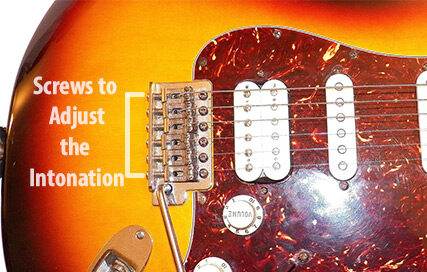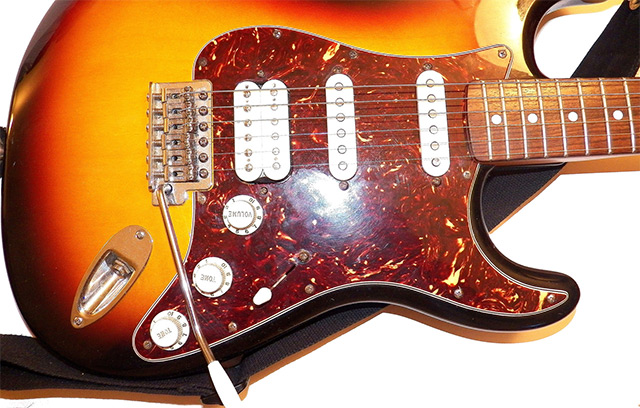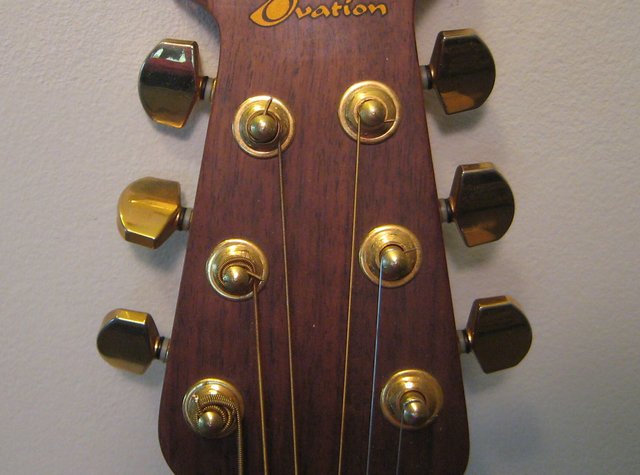One of the most frustrating things that can affect a guitar is tuning stability. The guitar won’t stay in tune whether it is new, old, cheap, or expensive. This article will discuss the top 9 reasons why your guitar won’t stay in tune. Along with tips to stop the guitar from slipping out of tune or at least minimize it to an extent, it is no longer a huge bother.
9 Reasons Why a Guitar Won’t Stay in Tune
Let’s discuss some of the common causes of tuning instability. You don’t need to check your guitar for every single one. Instead, see what might be affecting you. If you recently had your strings changed, you might want to check out the points that cover that.
The Nut
In all my years of playing and teaching experience, I’ve found that if a decent quality guitar gets out of tune, more often than not, it’s the nut.
The nut of the guitar can affect the tuning stability in two ways. First, if you bought a new guitar that just wouldn’t stay in tune, you might want to check the nut height. You might have to push down the strings very hard if the height is too much. And, the harder you press down, the greater the likelihood of the string going out of tune.
While the string action can be decreased by adjusting the truss rod, it wouldn’t fix a suboptimal nut. In which case, you will have to take your guitar to a luthier to file the nut a bit.
The nuts’ slotting is the second issue related to the nut, which may prevent the strings from sliding, causing tuning instability. This could be the prime suspect if you recently changed to a heavier gauge set of strings.
The slots in the nut are grooved for a specific gauge of strings. Heavier gauge or thicker strings would naturally not fit these slots or grooves, which may cause extra friction. This friction may cause the nut’s surface to scrape off, making the slot uneven. Such a nut may cause tuning stability issues and should be taken to a luthier.
In other cases, there could be friction between the strings and the nut despite the strings being the optimal gauge. In such cases, you might hear a pinch or a click when turning the tuners, and this means the string is getting stuck in the slot and isn’t properly sliding over it. To fix this, you can scrape the graphite of a pencil over the nut or scribble on it so that fine graphite particles go in the nut slot. The graphite acts as an excellent nut lubricant.
Old Strings
Strings have a lifespan as they are in constant contact with skin and many chemicals secreted from our bodies. Not to mention abuses such as pushing, bending, strumming, and slapping. All this impacts the strings’ longevity, affecting not only the tuning stability but also the sound produced.
There is a term for strings past their prime — “dead strings.” While some people like the sound of dead strings, they wouldn’t like their inability to stay in tune.
Most set of strings will last around a couple of months for guitarists who play an average of around 2 hours per day. This is a rough estimate, though, as the actual lifespan would depend on many factors such as string quality, coating (or the lack of it), playing style, etc.
If you think it has been months since you last restrung your guitar, and it sounds dull and looks visibly dirty and grimy (particularly the underside). Your best choice would be to buy a new set of strings. They are inexpensive, so having a set lying around wouldn’t be a problem if it doesn’t fix it.
New Strings
Like old strings, new ones can cause tuning issues and are sometimes more pronounced. If your guitar cannot hold its tuning even for the duration of your practice or playing, it could be those new strings you put. It is a best practice always to stretch your strings the first time you put them on (see the next section for details on how to do that).
New strings commonly stretch and keep losing their tuning for some days while they “break in.” If this is the case, you can stretch the strings to ensure they stay in tune.
Improperly Installed Strings
Bridges anchor the strings very firmly and aren’t usually the cause, but tuning pegs are another story. It is best to leave enough slack to wind the string a couple of extra times around the tuning posts. Some guitarists leave the strings uncut with long strings hanging out. While this may not look good and is unnecessary, it is better than having no slack.
To do this, put the string through the tuning post hole and wind it around once while keeping the string still reasonably loose. Now start turning the tuning peg to wind it a couple of times more as it tightens. Make sure these extra loops go underneath the first loop.
For unwound strings, it is better to loop them around 4–5 times for better stability.
Temperature and Climate
Strings are made of metal, and metals expand when heated. On top of this, humidity also affects wood, which can affect the shape of the neck of the guitar and affect the tuning. In a chilly climate where external heating is required indoors, sudden temperature changes may affect the tuning stability of your guitar.
If this is why your guitar won’t stay in tune, you can’t do much except re–tuning it every time you play. You can also try to keep the exposure of the guitar to these extreme temperature differences to a minimum by always putting it in a case while travelling.
Tuners or Machine Heads

The chance of the machine heads causing tuning issues is very slim in the case of a decent guitar. But, if nothing else seems to fix your issue, it is wise to check them.
Bad quality or worn–out (stiff) tuners may also cause a guitar to be unable to keep its tuning. If tuners are the cause, it will affect certain strings more than the others. If you feel that only certain strings keep getting out of tune rather than any random strings or all 6 of them, then the tuners may be the culprit.
Tuners in inexpensive guitars are especially prone to having these issues. If the guitar itself is in good shape, I recommend getting all the tuners replaced by a decent set. These would set you back by around $15, not including installation charges. If you have a screwdriver set and some DIY skills, you might be able to pull this off yourself.
Bridge Saddles

Loose or improperly adjusted saddles may affect the tuning stability along with the intonation of the strings. Intonation, in simple words, means the tuning accuracy of the string at different frets. So a string can be more or less in tune (open string) but when you fret it, say at the 5th fret, the note is just not right. Since tuning is done on open strings, the strings may have intonation issues despite being in the correct tuning.
In electric guitars, an improperly adjusted saddle may be causing this issue. Most bridges and saddles can be adjusted by either a screwdriver or an Allen key. Since there are various types of bridges on the market, you’ll have to research how yours can be adjusted.
Tremolo/Vibrato Bridge

Tremolo or vibrato bridges with no locking mechanism are much more susceptible to getting out of tune. The tremolo system can temporarily change the tension of the strings when using the tremolo or whammy bar. This change in tension changes the pitch making possible effects such as pitch bending and vibrato, among others.
While cool effects are possible with such a system, the tremolo arm can make the guitar go out of tune with all the stretching of the strings. It can happen with the use of the tremolo arm or even without it, though uncommon. If you use the tremolo arm too aggressively, you might even lose the tuning in the middle of a playing session.
Another common issue with floating bridges is that you often need multiple iterations to tune all six strings. This is because the sum of the tension exerted on the bridge keeps changing as you tune strings one by one. This change in tension affects the strings’ anchoring point, subsequently making the strings that have already been tuned to go slightly flat.
For someone unaware of this particular issue, it might look like the guitar is getting out of tune after tuning.
A special kind of tremolo bridge, a locking tremolo bridge, solves almost all these issues for the most part. They have better tuning stability, don’t go out of tune even with aggressive use of the tremolo bar and do not need multiple tuning iterations for each string. They are more expensive but can be worth it if you find yourself being annoyed by the issues mentioned.
Otherwise, get yourself a headstock tuners (pretty inexpensive) and tune your guitar whenever you feel like the tuning is going off. Many people, even stage performers, tune their guitars every so often. In fact, it is pretty standard for many of them to tune before playing each song.
Your Technique
Lastly, the reason your guitar is going out of tune may be because of your technique (or lack of it). Putting too much pressure while fretting is something all beginners tend to do. There is also a chance of strings getting bent because of the pressure. Employing too much pressure and wrong techniques can affect the guitar’s tuning.
Generally, the advice is to fret as lightly as possible to get a clean, crisp note. If done too aggressively, slapping and string bending techniques can also impact the tuning.
3 Tips to Make Your Guitar Stay in Tune
If you could find and rectify the cause of your guitar not staying in tune, the tips below will ensure your guitar stays in tune for longer. Even if you have no tuning issues, it is best to follow these general guidelines.
Stretch New Strings
When you put on a new set of strings, it is advisable to stretch them while tuning for the first time. This would save you a lot of headaches in the near future.
- To do this, restring the guitar and tune each of the strings to pitch.
- Start from any one of the strings from either side and grab it with your thumb and index finger at around the middle of the fretboard (12th fret)
- Now stretch the string by pulling it up and then pushing it down, do it a couple of times and then tune the string again. Don’t pull too hard. A quarter of an inch above the fretboard is enough. You’ll see that the strings go flat after stretching.
- Repeat this process for all six strings.
- Do this process again for each of the six strings.
Always Tune Up to Pitch
When tuning a string, always tune it up. If it goes too sharp (above the pitch), go down a bit more and then tune up. Strings almost always hold their tuning better when you do this rather than going down to the pitch.
Remember to do this when you’re stretching the strings as well.
Loop or Wind the Strings

You want to leave enough slack in the strings passing through the tuning post hole to be able to loop the string 2–5 times. This will hold the strings firmly in their place and minimize any slippage.
- After having anchored at the string in the bridge, pass it through the peg hole as usual.
- Grab the string at the 7th fret and pull it down to the 9th fret.
- Now start winding the string. The extra slack will ensure you get at least three loops around the tuning post.
- For thinner strings, getting a couple more wraps is better.
Final Thoughts
A guitar’s lack of tuning stability is something almost all guitarists will encounter in their music journey. This issue could make a beginner pull their hairs out, wondering why their guitar won’t stay in tune.
Luckily, more often than not, the cause could be one of the above that we discussed, in which case it would be resolvable. And you wouldn’t have to take a trip to a luthier and spend money. Our tips will also ensure your guitar stays in tune and offers an all–around better playability.


